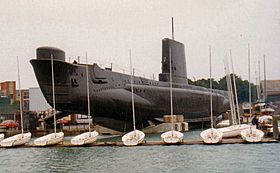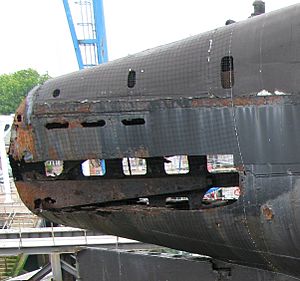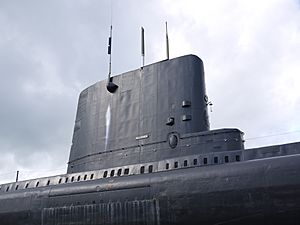HMS Alliance (P417) facts for kids

HMS Alliance on display at Royal Navy Submarine Museum
|
|
Quick facts for kids History |
|
|---|---|
| Ordered | 1943 Emergency war programme |
| Builder | Vickers Armstrong, Barrow-in-Furness |
| Laid down | 13 March 1945 |
| Launched | 28 July 1945 |
| Commissioned | 14 May 1947 |
| Decommissioned | 1973, static training boat until August 1979 |
| Identification | Pennant number: P417 (S67 from 1961) |
| Fate | Museum ship/memorial since 1981 at Royal Navy Submarine Museum |
| General characteristics | |
| Displacement |
|
| Length | 281 ft 4.75 in (85.7695 m) |
| Beam | 22 ft 3 in (6.78 m) |
| Draught | 17 ft (5.2 m) |
| Propulsion | Two 2,150 hp (at 450 rpm) supercharged Vickers 8-cylinder diesel engine, Two 625 hp electric motors for use underwater, driving two shafts |
| Speed |
|
| Range |
|
| Endurance | 36 hours submerged at 2.5 knots |
| Test depth | 500 ft (150 m) |
| Complement | 5 officers, 56 ratings (63 ratings after modernisation in 1960) |
| Armament |
|
HMS Alliance is a famous submarine from the Royal Navy. It belongs to a group of submarines called the Amphion-class. This submarine was started near the end of World War II and finished in 1947. Today, Alliance is the only submarine of its kind still existing. It has been a special memorial and a museum ship since 1981.
The Amphion-class submarines were made for long journeys, especially in the Far East. The huge Pacific Ocean meant they needed to travel far and fast on the surface. They also needed to be comfortable for the crew. This allowed them to patrol larger areas and stay at sea for longer times. Alliance was one of seven submarines in its class that had a snort mast. This device allowed the submarine to run its diesel engines and get fresh air while submerged.
Contents
History of HMS Alliance
From October to November 1947, Alliance went on a long test trip. It sailed in the Atlantic Ocean near Africa. During this trip, it stayed underwater for 30 days. This helped the Navy learn how well the snort mast worked.
Modernizing the Submarine
Between 1958 and 1960, Alliance got a big upgrade. Its deck gun and outside torpedo tubes were taken off. The hull, which is the main body of the submarine, was made smoother. The fin, which is like a tower on top, was replaced with a bigger, more streamlined one. This new fin was made of aluminum and was about 26 feet tall.
These changes made the submarine quieter and faster when it was underwater. After the upgrades, the radio antenna was moved. It was first on a frame behind the fin. Later, it was replaced with a whip antenna on the side of the fin. This new antenna could be moved flat using hydraulics.
Even with the changes, the old opening for the gun was kept. This meant Alliance could have a small deck gun again. This happened when it served in the Far East during the Indonesian Confrontation in the early 1960s.
Changes and Incidents
In May 1961, the numbers on British submarines were changed. All submarines built after World War II were given numbers starting from S01. Alliance received the number S67.
On January 13, 1968, the submarine accidentally ran aground. This happened on Bembridge Ledge near the Isle of Wight. Luckily, it was later pulled free with help from Navy tugboats. In September 1971, there was an incident involving a battery on board. It happened while the submarine was at Portland Harbour. Several sailors were injured.
From Service to Museum
From 1973 to 1979, Alliance was used as a training submarine. It stayed still at the HMS Dolphin naval base. In August 1979, it was moved to a shipyard in Southampton. Its keel, the bottom part of the ship, was made stronger. This was so it could be lifted out of the water. The goal was to keep it safe as a memorial. It honors all British submariners who lost their lives while serving.
Since 1981, the submarine has been a museum ship. It is lifted out of the water and displayed at the Royal Navy Submarine Museum in Gosport.
Restoration Efforts
Alliance is an important part of the National Historic Fleet. However, over the years, many pigeons had been nesting inside it. This caused a lot of damage from corrosion. Also, it sat on supports over seawater, which made the corrosion worse. This made it hard to maintain the outside of the submarine.
Urgent repairs were needed to save this historic vessel. In May 2011, it was announced that HMS Alliance would get a large grant. It received £3.4 million from the Heritage Lottery Fund. This money was used to fix its front and back sections. It also helped to deal with the widespread rust on its surface.
The restoration project also included building land beneath Alliance. This was done using a special wall called a cofferdam and then filling the area. This makes it easy to reach the submarine for future repairs. It also created a new viewing area for visitors. The project also opened up the conning tower and casing for people to explore. A new HMS Alliance gallery was also part of the plan. This helps visitors understand how important this submarine is and what it represents.
The restoration work was finished by March 2014. The submarine was then opened to visitors at the Royal Navy Submarine Museum in April.
Images for kids






